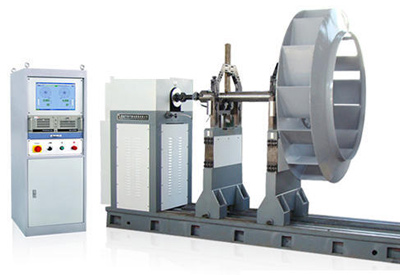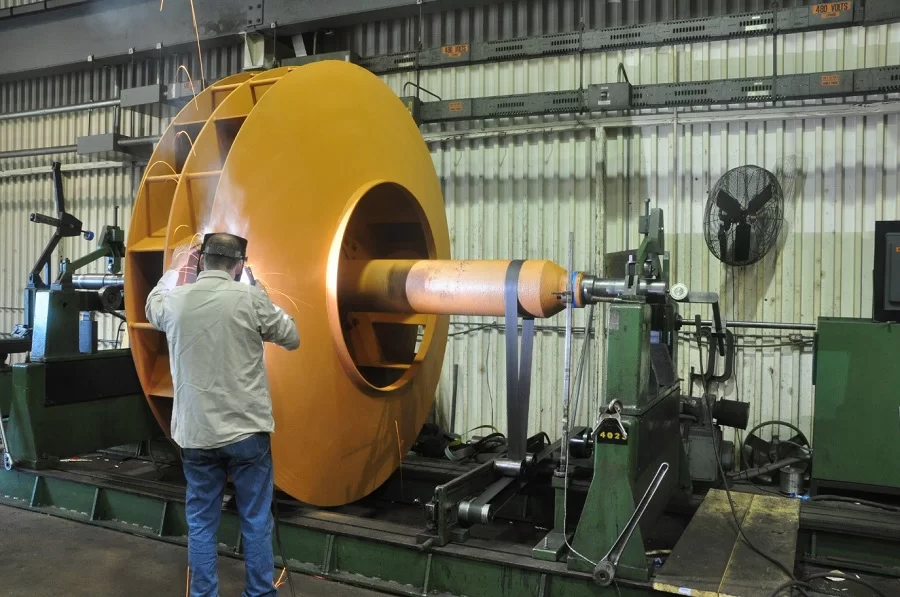Balancing Various Types of Fan Blades
What is fan blade balancing?
Fan blade balancing is a process to minimize vibration, noise, and bearing wear in rotating machinery. Fans and pumps require proper blade balancing to prevent cavitation. The blades must rotate correctly in the pump to avoid issues, but a single-phase electrical source does not pose a problem. However, a three-phase electrical source must follow the appropriate electrical wiring.
Balancing is always one of the most cost-effective ways to ensure equipment quality.
There are two types of balancing: workshop balancing and on-site balancing.
What is workshop static balancing?
In static balancing operations, the center of gravity of rotating bodies must align with the axis of rotation, so the effects of neutralizing forces must be addressed to achieve balance. This type of balancing has a significant impact on the precise operation and efficiency of industrial components, so it should always be given attention. Workshop balancing can be performed in three ways: static balancing (single plane), dynamic balancing (two planes), and couple balancing (three planes).
What devices are used for workshop balancing services?
Workshop balancing can be easily performed by professional technicians using horizontal and vertical devices with various capacities (300 kg, 1000 kg, 5000 kg, etc.) in the workshop. These devices are equipped with computer systems and can print balance results. They can handle components of various diameters and weights.
On-site Balancing:
Most of the root causes of vibration-related defects are related to unbalance, and the quickest and least expensive solution to this problem is on-site balancing.
Single-plane and two-plane balancing by the method of coefficients of influence and the application of test masses is the most common on-site balancing method.
With this method, there is no need to open the rotor or send it to the workshop, and installation errors are compensated during balancing. Moreover, there are no limitations on the dimensions and weight of the rotor.
The balancing process with the VB95 device is straightforward and routine, yet the advanced features of the device enable the operator to control the different stages, making it suitable for professional balancing work.
The VB95 device stores data step by step, and calibration data for each balance can be recalled at any time.
Fuzzy correlation:
In addition to improving the accuracy of unbalance vector calculation in identifying and separating mechanical and electrical defects and separating vibrations that have reached a point from two different machines, fuzzy correlation is very useful. This method can easily replace time-domain averaging techniques.

Balancing Features:
- Single-plane balancing
- Two-plane balancing
- Fast and accurate calculation method for amplitude, phase, and averaging
- Polar representation of various balancing stages
- Table of various balancing stages
- Calculation and display of permissible values according to ISO 1940 standard
- Mass breakdown
- Calibration storage for future balancings without applying test masses
- Ability to change temporary or permanent mass conditions without the need for rebalancing
- Calculation of balancing success percentage
- Protection against speed changes during balancing stages
- Display of amplitude and phase history
Benefits of Fan Blade Balancing:
- Improved operational quality
- Increased equipment lifespan
- Minimization of vibrations
- Reduction of noise
- Minimization of structural fatigue stresses
- Reduction of operator fatigue and discomfort
- Increased bearing lifespan
- Increased sealing element lifespan
- Reduced electrical losses
- Decreased maintenance
- Smooth equipment operation
- Savings in costs, time, labor, etc.
Why Should Fan Blade Balancing Be Done?
The consequences of unbalanced fan blades include:
- Increased stress on shafts
- Elevated temperatures in bearings and reduced grease and bearing lifespans
- Rapid belt breakage
- Excessive noise
- Increased vibration upon device shutdown
- Reduced ability to detect other issues in industrial fans
- Creation of unbalanced loads on electric motors by belts and shafts
Requirements for Industrial Fan blade Balancing:
In case of the above issues, ensure that unbalance is the cause, and initial measures should be taken. If placing a corrective weight on the fan is feasible, it is better to perform on-site fan balancing on the bearings. Otherwise, disassembly and workshop balancing should be considered.
The main reasons for fan blade unbalance are:
- Accumulated and oxidized dust around the fan blade
Industrial ventilation fan blades in mines, steam boilers, and dusty workshops are more susceptible to such issues. Dust particles like dust and debris in the air attach to the fan blade day by day, and it is unlikely that these dust and debris adhere uniformly to the fan blade, thus causing imbalance and unbalance.
The fan blade surface easily oxidizes at high temperatures, and after oxidation, it creates a thick oxide layer. The connection force between these layers and the fan blade surface is not uniform, and some layers fall off automatically due to vibration or centrifugal force, which causes fan unbalance.
Therefore, if possible, the fan blade should be kept clean, and dust, debris, and rust on the fan blade should be cleaned regularly.
- Fan blade wear
Some large dust and fine particles pass through the ventilation fan blade at high temperatures and high-speed flue gas, which affects the fan blade more and more over time, causing wear and scratches on the blade outlet. At this time, the fan blade requires balancing or replacement.

